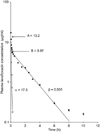1. Ahanger AA, Srivastava AK, Raina R. Disposition kinetics of enrofloxacin in crossbred calves. J Vet Pharmacol Toxicol. 2003. 3:16–20.
2. Aliabadi FS, Lees P. Pharmacokinetics and pharmacodynamics of danofloxacin in serum and tissue fluids of goats following intravenous and intramuscular administration. Am J Vet Res. 2001. 62:1979–1989.

3. Aliabadi FS, Ali BH, Landoni MF, Lees P. Pharmacokinetics and PK-PD modeling of danofloxacin in camel serum and tissue cage fluids. Vet J. 2003. 165:104–118.
4. Aliabadi FS, Landoni MF, Lees P. Pharmacokinetics (PK), pharmacodynamics (PD) and PK-PD integration of danofloxacin in sheep biological fluids. Antimicrob Agents Chemother. 2003. 47:626–635.

5. Apley MD, Upson DW. Lung tissue concentrations and plasma pharmacokinetics of danofloxacin in calves with acute pneumonia. Am J Vet Res. 1993. 54:937–943.
6. Arret B, Johnson DP, Kirshbaum A. Outline of details for microbiological assays of antibiotics: second revision. J Pharm Sci. 1971. 60:1689–1694.

7. Atef M, El-Gendi AY, Aziza , Amer MM, Abd El-Aty AM. Some pharmacokinetic data for danofloxacin in healthy goats. Vet Res Commun. 2001. 25:367–377.
8. Bakken JS. The fluoroquinolones: how long will their utility last? Scand J Infect Dis. 2004. 36:85–92.

9. Chulavatnatol S, Chindavijak B, Vibhagool A, Wananukul W, Sriapha C, Sirisangtragul C. Pharmacokinetics of levofloxacin in healthy Thai male volunteers. J Med Assoc Thai. 1999. 82:1127–1135.
10. Davis R, Bryson HM. Levofloxacin. A review of its anti-bacterial activity, pharmacokinetics and therapeutic efficacy. Drugs. 1994. 47:677–700.
11. Destache CJ, Pakiz CB, Larsen C, Owens H, Dash AK. Cerebrospinal fluid penetration and pharmacokinetics of levofloxacin in an experimental rabbit meningitis model. J Antimicrob Chemother. 2001. 47:611–615.

12. Dumka VK, Srivastava AK. Pharmacokinetics, urinary excretion and dosage regimen of levofloxacin following single intramuscular administration in cross bred calves. J Vet Sci. 2006. 7:333–337.

13. Dumka VK, Srivastava AK. Disposition kinetics, urinary excretion and dosage regimen of levofloxacin formulation following single intravenous administration in crossbred calves. Vet Res Commun. 2007. 31:873–879.

14. Edelstein PH, Edelstein MA, Lehr KH, Ren J.
In-vitro activity of levofloxacin against clinical isolates of Legionella spp, its pharmacokinetics in guinea pigs, and use in experimental
Legionella pneumophila pneumonia. J Antimicrob Chemother. 1996. 37:117–126.

15. Gibaldi M, Perrier D. Gibaldi M, Perrier D, editors. Method of residuals. Pharmacokinetics. 1982. 2nd ed. New York: Marcel Dekker;433–444.
16. Gips M, Soback S. Norfloxacin nicotinate pharmacokinetics in unweaned and weaned calves. J Vet Pharmacol Ther. 1996. 19:130–134.

17. Ito T, Yano I, Masuda S, Hashimoto Y, Inui K. Distribution characteristics of levofloxacin and grepafloxacin in rat kidney. Pharm Res. 1999. 16:534–539.
18. Kaartinen L, Salonen M, Alli L, Pyörälä S. Pharmacokinetics of enrofloxacin after single intravenous, intramuscular and subcutaneous injections in lactating cows. J Vet Pharmacol Ther. 1995. 18:357–362.

19. Klesel N, Geweniger KH, Koletzki P, Isert D, Limbert M, Markus A, Riess G, Schramm H, Iyer P. Chemotherapeutic activity of levofloxacin (HR 355, DR-3355) against systemic and localized infections in laboratory animals. J Antimicrob Chemother. 1995. 35:805–819.

20. Langtry HD, Lamb HM. Levofloxacin. Its use in infections of the respiratory tract, skin, soft tissues and urinary tract. Drugs. 1998. 56:487–515.
21. McKellar QA, Sanchez Bruni SF, Jones DG. Pharmacokinetic/pharmacodynamic relationship of antimicrobial drugs used in veterinary medicine. J Vet Pharmacol Ther. 2004. 27:503–514.

22. North DS, Fish DN, Redington JJ. Levofloxacin, a second-generation fluoroquinolone. Pharmacotherapy. 1998. 18:915–935.






 PDF
PDF ePub
ePub Citation
Citation Print
Print


 XML Download
XML Download